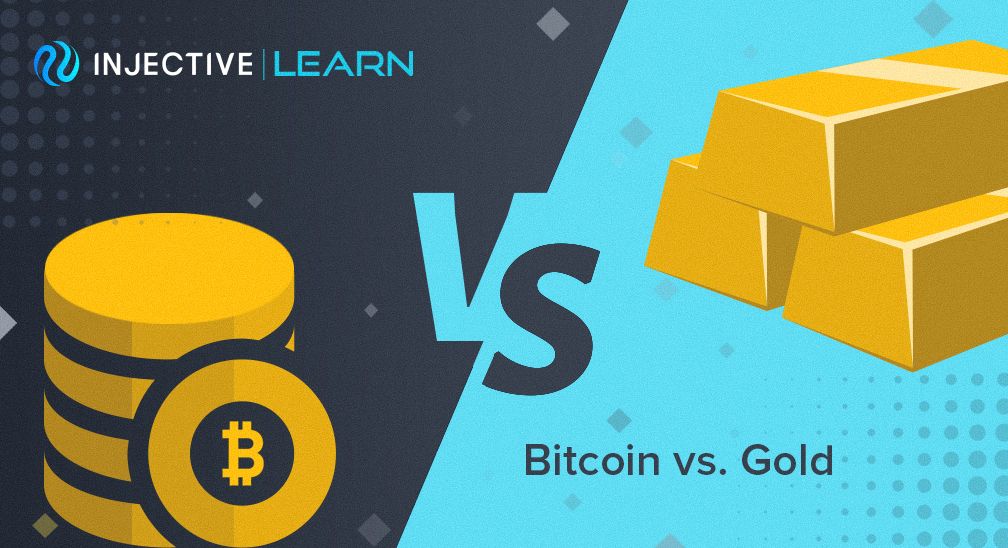Throughout history, gold was used in society to preserve wealth and as such was viewed as a "store of value". More recently, gold has been seen as a great hedge against inflation, providing traders and investors with an alternative investment vehicle. However, as a base metal, large quantities of gold would still need to be stored and transported by centralized custodians which entails that individuals lose ownership of their assets while handing over complete control to a third-party.
The promise of Bitcoin is to recreate the “store of value” property of gold in a digitally represented asset. Over the last decade, it has emerged into its moniker of “digital gold” and is now being actively adopted by many institutions.
This piece will explore both assets in-depth with a focus on their key features: scarcity, baseline/intrinsic value, storability and fungibility.
Scarcity
Paper money was originally backed by gold, widely known as the gold standard wherein countries agreed to value fiat currencies based on gold’s circulating supply due to its scarcity. The confidence to rely the monetary system on gold's supply mainly derives from the fact that gold comprises only around 0.00000031% of the Earth's crust, making it extremely scarce and valuable. Even though the gold industry is developing exponentially, the amount of unmined gold is still unknown and gold's supply may also be affected by external factors such as space exploration.
Bitcoin’s scarcity is encoded and controlled by algorithms. Indeed, the total number of coins mined is limited to a maximum supply of 21 million.
At the time of writing, there are 18,711,137.5 bitcoins in existence. This number changes around every 10 minutes when new blocks are mined. Right now, each new block adds 6.25 bitcoins into circulation. This “mining logic” is ensured by Bitcoin’s algorithmic policies that enforces “halving” every 4 years, which lowers Bitcoin’s inflation rate in half. In practice this means that by the time of the next halving, each new block will add only 2.125 coins into circulation. The reward will continue to halve until the final bitcoin has been mined, which is expected to happen around the year 2140.
Baseline/Intrinsic Value
Bitcoin derives much of its baseline value from the cost of securing the network. The consensus mechanism that is used in Bitcoin’s blockchain is called Proof-of-Work (PoW), which requires miners to run special hardware in order to participate in the network. Strikingly, the mining algorithm is “energy-intensive by design”, since it is their high energy consumption that protects PoW blockchains from malicious attacks.
As the Bitcoin ecosystem grows and the number of miners increase, the difficulty in the mathematical computations to validate transactions increases substantially, making the network more powerful and resistant to attacks. It was estimated that in early 2020, a corroborated group of individuals or centralized entity would need to invest over $1billion dollars in computing power and electricity to disrupt the Bitcoin network.
Conversely, gold as a precious metal, earns its value via numerous use cases in the real world such as coinage, jewellery, and art. Gold's unique chemical and physical properties allow it to be used in electronics for electrical connectors and in a wide range of computerized devices. Moreover, gold is utilized in colored-glass production, infrared shielding, and dentistry.
Safety and Storability
The centuries old gold industry has developed advanced systems to weigh, verify, track and trade physical gold. Therefore, counterfeit forms of gold such as blocks of cheaper metal plated with gold are relatively easy to detect.
Gold can be safely stored in banks and professional vaults which are fully insured. However, on an individual level, gold can be harder to store safely as it can be stolen from your dwellings. In addition to that it’s also impractical to store large quantities of gold in coins or bullions.
Bitcoin is stored in non-custodial wallets - that is private wallets that are protected by private keys. Digital assets are fully transparent since public keys can be used in an explorer to view account balances and private keys provide full control over one's funds as only the people who have access to the private keys can execute transactions.
While one can simply memorize their private key to interact with the network directly, a more user-friendly way is to use hot or cold wallets. Hot storage wallets are applications (i.e. Metamask) that store the user's private key and abstract away the complexity of transaction verification to a click of the button. Since these applications are constantly online, there have been cases when hackers were able to gain access to users’ private keys and control their wallets without their consent. Cold storage wallets (i.e. Ledger or Trezor) are less susceptible to attacks as they are physical devices that store the user’s private keys offline and are not connected to the Internet unless a transaction needs to be approved by the key owner.
It is clear that as a digital asset, Bitcoin is available to more individuals who wish to hold any amount of the asset discreetly, which is essentially impossible with a physical metal like gold.
Fungibility
Fungibility refers to the ability of a good or an asset to be interchangeably replaced by other goods or assets of the same type. That is, units of fungible assets are equivalent, like dollar bill notes for example.
Bitcoin is highly fungible with each whole BTC being made up of 100,000,000 units. Each Bitcoin unit or 0.00000001 BTC is called a Satoshi or Sat, and each BTC is divisible to the 8th decimal place with a Satoshi being the smallest unit of Bitcoin. Each unit can be freely exchanged for another Satoshi, meaning that each Satoshi is equivalent to every other Satoshi.
Gold is generally considered fungible with one gold ounce being equivalent to another ounce of gold; however, the fungibility of gold is not entirely universal. In reality, gold bars and coins must undergo inspection and weighing to ensure that refinement and purity standards have been met. Moreover, individual institutions may impose their own restrictions and requirements with regards to the transferability and acceptance of gold bars.
Liquidity
Gold and Bitcoin are both highly liquid markets. Gold has a daily volume in excess of $145.5B while Bitcoin has a daily volume of around $12B. Both of these assets can be traded against a wide selection of leading fiat currencies.
Volatility
Just like any new technology, Bitcoin is still in the early ages of discovering its market equilibrium price, which makes it susceptible to speculations. This is reflected by the high volatility with common Bitcoin daily price swings of around 5%. While certain investors are able to capitalize on these price swings, others often lose money within those transactions. For instance, a recent tweet by Elon Musk caused a 20% drop in the Bitcoin price from around $55,000 to $42,000. Nonetheless, in the long run, Bitcoin has recorded unparalleled gains since its inception. In addition, many institutions today believe that as Bitocin is more widely accepted, the price fluctuations will be largely minimized.
By contrast, gold is more stable and is perceived as a safe hedge against inflation - that is the relatively falling value of fiat currencies. Even though gold fluctuates in value, the asset’s price swings generally occur over much longer time frames. As such, gold is more resilient to sudden price movements compared to Bitcoin as it might take months or years for the asset’s price to change substantially.
Bitcoin Vs Gold: Price Performance
Gold
Looking at the price of gold over the last decade, an ounce of gold was priced at around $1,130 in January 2009 and rose to a high of $2,095 in August 2011. However, the price fell over the next few years and retraced back below $1,250 at the end of 2015. Gold went on to trade sideways for the next four years, before going on to surpass $1,500 in August 2019. The price continued to rise over 2020 and stood at around $1,800 as of May 2021.
Bitcoin
The price of Bitcoin has been extremely volatile over the same time period with 1 BTC being worth around $0.0008 at its inception in 2009. The price appreciated significantly in 2010 as BTC hit $0.08, and after fluctuating over the next few years Bitcoin broke $1,000 for the first time in December 2013. However, the price retraced and BTC remained relatively stable until 2017 when it ran up from just over $1,000 on January 1 to reach $19,783 in December of 2017. Despite falling back to below $4,000 in 2019, BTC is believed to have entered a new cycle reaching an all-time high of $63,729 in April 2021.
The price of one Bitcoin surpassed that of a single troy ounce of gold for the first time on March 2, 2017 when Bitcoin stood at $1,271 while an ounce of gold was priced at $1,235.
As a result, while the price of gold has increased by around 60% since 2009, Bitcoin has increased in value by more than 11,000,000%.
Bitcoin on the Blockchain
There are a number of projects that aim to combine the best characteristics of both assets such as Digix Global (DGX), Pax Gold (PAXG), and Tether Gold (XAUT). The aforementioned are digital tokens that can be transferred and stored similarly to Bitcoin. Each token is backed by a unit of physical gold which is stored with a fully auditable custodial service.
Different iterations of Bitcoin have also been seen such as wrapped BTC (wBTC) which represents Bitcoin on the Ethereum blockchain.
Closing Thoughts
For now, it seems the debate on whether Bitcoin will replace gold will continue. Relative to gold, Bitcoin is still in its infancy and has shown to be a contender for replacing gold in the digital world.

About Injective
Injective is a lightning fast interoperable layer one blockchain optimized for building the premier Web3 finance applications. Injective provides developers with powerful plug-and-play modules for creating unmatched dApps. INJ is the native asset that powers Injective and its rapidly growing ecosystem. Injective is incubated by Binance and is backed by prominent investors such as Jump Crypto, Pantera and Mark Cuban.
Website | Telegram | Discord | Blog | Twitter | Youtube | Facebook | LinkedIn | Reddit | Instagram | Orbit Newsletter



